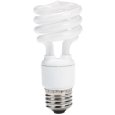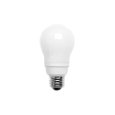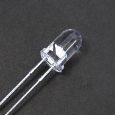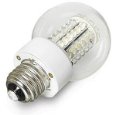Compact Fluorescent Lamps:
Compact fluorescent lamps (CFL) (Figure 4) are very similar in construction to regular fluorescent lamps. They differ in that the gas used inside the tube is created by heating mercury to mercury vapor and the coating on the inside of the tube is fluorite rather phosphorous. The ballast is located in the base of the lamp.

Figure 4 - Typical compact fluorescent lamp (CFL)
They have a long life, usually better than 7,500 hours.
The bulbs are made in a variety of shapes and in some cases are encapsulated in a glass bulb (Figure 5), to give the appearance of an incandescent lamp.

Figure 5 - CFL made to look like incandescent bulb
CFL's are much more efficient than incandescent or halogen light bulbs in energy versus light output. Table 1 shows a comparison between equivalent light outputs of a CFL versus incandescent bulbs.
| Table 1 - Comparison of Compact Fluorescent Lamps (CFL) & Incandescent Lamps | |
| Incandescent Lamp Watts | Compact Fluorescent Lamps (CFL) Watts |
40 |
7 - 10 |
60 |
15 - 18 |
75 |
20 |
100 |
20 - 25 |
150 |
32 |
Note: Ratings are based on manufactures information.
CFL's are being promoted as one method to save energy and while they have a greatly reduced energy consumption compared to standard incandescent lamps, they have a number of negatives associated with them:
- They are not inexpensive and cost 7 to 10 times more than an incandescent lamp with the same light output.
- In most cases they are larger than the equivalent incandescent bulb, making them difficult to use in some locations and in some light fixtures.
- The manufacturer's have a tendency to exaggerate the equivalent light output as compared to an incandescent light bulb. In some cases by as much as 20%.
- Because they are filled with mercury that must turn into a vapor with an integral heating element, they require a start-up period before producing their maximum light output. In many cases this can be as long as 3 minutes.
- They are known to produce RFI (radio frequency interference) which can be heard through certain pieces of electronic equipment such as radios, home entertainment systems. wireless phones, cell phones, wireless modems and routers.
- Not all CFLs are dimmable and not all standard dimmers will control CFLs that are dimmable.
- They have a relatively tight ambient operating temperature, which makes them poor choices for geographic areas that have freezing or very hot (over 100 degree) outdoor temperatures.
- The mercury inside the bulb, although a very small quantity, can be a hazard if the lamp is broken.

Figure 6 - LED indicator lamp

Figure 7 - LED lamp
Light Emitting Diodes (LED):
With the negatives associated with compact fluorescent lamps (CFL), it is my belief that it is the light emitting diode that will eventually be the standard for residential, commercial and industrial lighting.
LED technology has been around for almost a century. It does not use a filament, it does not require any gas or a vacuum within the enclosure. An electrical current is passed through a semi-conductor material which then produces light.
LED's have been used for indicator lamps for years (Figure 6). They have exceptional life, in the order of hundred's of thousands of hours, and are 5 times more efficient than fluorescent lamps.
To create a light bulb, a number of LED lamps are placed on the same base (Figure 7). Currently, they can only produce relatively low amounts of light, but that is increasing every day.
